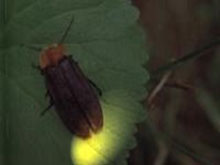How do fireflies flicker?
[ 2006-06-23 09:59 ]
“一閃一閃亮晶晶�,滿天都是小星星。”你小時(shí)候有沒有抓過螢火蟲玩���?靜謐的夜里,螢火蟲的小燈籠就像天上的星星那樣閃耀�����。那時(shí)候我們都以為螢火蟲會發(fā)光一定是種魔法��。那么�,它真正的發(fā)光原理是什么呢?趕快讀讀下面的文章��、尋找答案吧����!
 Memories of childhood include many things, the most
spectacular of which may be hundreds of fireflies flickering over the fields
covered by an evening mist. Memories of childhood include many things, the most
spectacular of which may be hundreds of fireflies flickering over the fields
covered by an evening mist.
Fireflies seem almost magical with their ability
to produce light as they fly effortlessly above the grassy fields.
But it is not magic which creates the luminescence. The glow of the firefly
is made by a chemical reaction within their bodies. A chemical called
luciferin produces the glow when an
enzyme called luciferase is mixed with it. Oxygen is required
for this reaction and is supplied by a special opening in the abdomen of the fireflies' body. The lightning bug,
as this little insect is popularly called, can control the intensity of the
flash by varying the amount of oxygen mixed with the luciferase.
Most light forms we are familiar with produce heat. However the firefly has a
very efficient means of producing light because no heat comes from the light it
emits. This phenomenon of light produced without heat is called luminescence. If living  organisms, such as lightning bugs, plankton in sea, or other creatures and plants,
produce light, it is called
bioluminescence. The light colors of fireflies can also vary by
species and can be yellow, green, orange, or red. Some types of lightning bugs
can produce two different colors of light. organisms, such as lightning bugs, plankton in sea, or other creatures and plants,
produce light, it is called
bioluminescence. The light colors of fireflies can also vary by
species and can be yellow, green, orange, or red. Some types of lightning bugs
can produce two different colors of light.
Almost 2000 different species of fireflies have been discovered, most in the
tropics. Biologists have studied them extensively, but we still don't know all
there is to know about these fascinating insects.
luciferin: 熒光素
luciferase: 熒光素酶
enzyme: 酵
abdomen:
下腹部
luminescence:(無熱的)發(fā)光
bioluminescence: 生物發(fā)光
plankton:
浮游生物
(英語點(diǎn)津Annabel編輯)
|